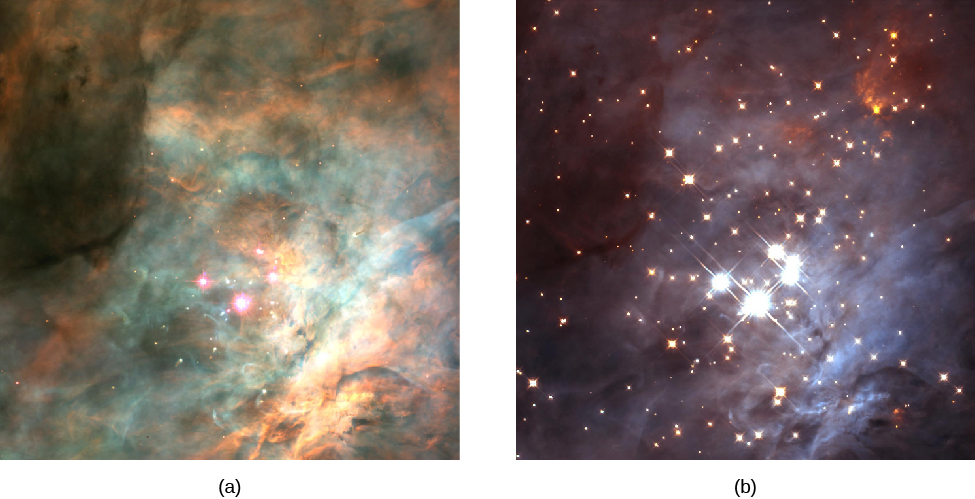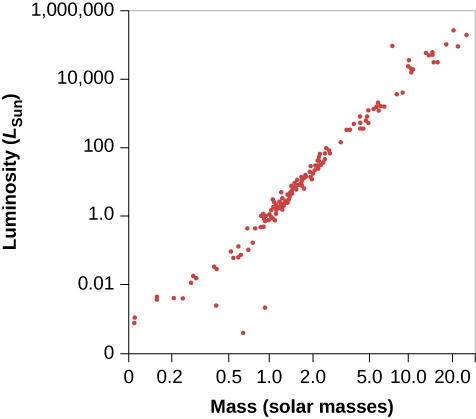| << Chapter < Page | Chapter >> Page > |
According to theoretical calculations, the smallest mass that a true star can have is about 1/12 that of the Sun. By a “true” star, astronomers mean one that becomes hot enough to fuse protons to form helium (as discussed in The Sun: A Nuclear Powerhouse ). Objects with masses between roughly 1/100 and 1/12 that of the Sun may produce energy for a brief time by means of nuclear reactions involving deuterium, but they do not become hot enough to fuse protons. Such objects are intermediate in mass between stars and planets and have been given the name brown dwarfs ( [link] ). Brown dwarfs are similar to Jupiter in radius but have masses from approximately 13 to 80 times larger than the mass of Jupiter. Exactly where to put the dividing line between planets and brown dwarfs is a subject of some debate among astronomers as we write this book (as is, in fact, the exact definition of each of these objects). Even those who accept deuterium fusion (see The Birth of Stars and the Discovery of Planets outside the Solar System ) as the crucial issue for brown dwarfs concede that, depending on the composition of the star and other factors, the lowest mass for such a dwarf could be anywhere from 11 to 16 Jupiter masses.

Still-smaller objects with masses less than about 1/100 the mass of the Sun (or 10 Jupiter masses) are called planets. They may radiate energy produced by the radioactive elements that they contain, and they may also radiate heat generated by slowly compressing under their own weight (a process called gravitational contraction). However, their interiors will never reach temperatures high enough for any nuclear reactions, to take place. Jupiter, whose mass is about 1/1000 the mass of the Sun, is unquestionably a planet, for example. Until the 1990s, we could only detect planets in our own solar system, but now we have thousands of them elsewhere as well. (We will discuss these exciting observations in The Birth of Stars and the Discovery of Planets outside the Solar System .)
Now that we have measurements of the characteristics of many different types of stars, we can search for relationships among the characteristics. For example, we can ask whether the mass and luminosity of a star are related. It turns out that for most stars, they are: The more massive stars are generally also the more luminous. This relationship, known as the mass-luminosity relation , is shown graphically in [link] . Each point represents a star whose mass and luminosity are both known. The horizontal position on the graph shows the star’s mass, given in units of the Sun’s mass, and the vertical position shows its luminosity in units of the Sun’s luminosity.

We can also say this in mathematical terms.
It’s a reasonably good approximation to say that luminosity (expressed in units of the Sun’s luminosity) varies as the fourth power of the mass (in units of the Sun’s mass). (The symbol ~ means the two quantities are proportional.) If two stars differ in mass by a factor of 2, then the more massive one will be 2 4 , or about 16 times brighter; if one star is 1/3 the mass of another, it will be approximately 81 times less luminous.
Now we can take the 4th root of both sides, which is equivalent to taking both sides to the 1/4 = 0.25 power. The formula in this case would be:
In
Appendix J , Sirius is listed with a luminosity 23 times that of the Sun. This value can be inserted into the mass-luminosity relationship to get the mass of Sirius:
The mass of the companion star to Sirius is then 3.2 – 2.2 = 1.0 solar mass.
Notice how good this mass-luminosity relationship is. Most stars (see [link] ) fall along a line running from the lower-left (low mass, low luminosity) corner of the diagram to the upper-right (high mass, high luminosity) corner. About 90% of all stars obey the mass-luminosity relation. Later, we will explore why such a relationship exists and what we can learn from the roughly 10% of stars that “disobey” it.
The masses of stars can be determined by analysis of the orbit of binary stars—two stars that orbit a common center of mass. In visual binaries, the two stars can be seen separately in a telescope, whereas in a spectroscopic binary, only the spectrum reveals the presence of two stars. Stellar masses range from about 1/12 to more than 100 times the mass of the Sun (in rare cases, going to 250 times the Sun’s mass). Objects with masses between 1/12 and 1/100 that of the Sun are called brown dwarfs. Objects in which no nuclear reactions can take place are planets. The most massive stars are, in most cases, also the most luminous, and this correlation is known as the mass-luminosity relation.

Notification Switch
Would you like to follow the 'Astronomy' conversation and receive update notifications?